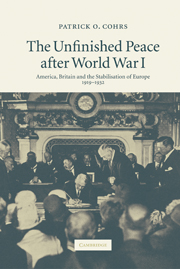Book contents
- Frontmatter
- Contents
- Acknowledgements
- List of abbreviations
- A note on the footnotes and bibliography
- Introduction
- Prologue
- 1 The wider challenges
- 2 Wilson, Lloyd George and the quest for a ‘peace to end all wars’
- 3 The ill-founded peace of 1919
- 4 The escalation of Europe's post-Versailles crisis, 1920–1923
- Part I The Anglo-American stabilisation of Europe, 1923–1924
- Part II Europe's nascent Pax Anglo-Americana, 1924–1925
- Part III The unfinished transatlantic peace order: the system of London and Locarno, 1926–1929
- 17 Sustaining stability, legitimating peaceful change
- 18 Progressive visions and limited commitments
- 19 ‘Reciprocity’?
- 20 The new European concert – and its limits
- 21 Thoiry – the failed quest for a ‘final postwar agreement’
- 22 Towards peaceful change in eastern Europe?
- 23 Achievements and constraints
- 24 No ‘new world order’
- 25 The initiation of the Young process
- 26 The last ‘grand bargain’ after World War I
- Epilogue
- Conclusion
- Map: Post-World War I Europe after the peace settlement of Versailles
- Bibliography
- Index
23 - Achievements and constraints
The European security system of the latter 1920s
Published online by Cambridge University Press: 21 July 2009
- Frontmatter
- Contents
- Acknowledgements
- List of abbreviations
- A note on the footnotes and bibliography
- Introduction
- Prologue
- 1 The wider challenges
- 2 Wilson, Lloyd George and the quest for a ‘peace to end all wars’
- 3 The ill-founded peace of 1919
- 4 The escalation of Europe's post-Versailles crisis, 1920–1923
- Part I The Anglo-American stabilisation of Europe, 1923–1924
- Part II Europe's nascent Pax Anglo-Americana, 1924–1925
- Part III The unfinished transatlantic peace order: the system of London and Locarno, 1926–1929
- 17 Sustaining stability, legitimating peaceful change
- 18 Progressive visions and limited commitments
- 19 ‘Reciprocity’?
- 20 The new European concert – and its limits
- 21 Thoiry – the failed quest for a ‘final postwar agreement’
- 22 Towards peaceful change in eastern Europe?
- 23 Achievements and constraints
- 24 No ‘new world order’
- 25 The initiation of the Young process
- 26 The last ‘grand bargain’ after World War I
- Epilogue
- Conclusion
- Map: Post-World War I Europe after the peace settlement of Versailles
- Bibliography
- Index
Summary
In April 1928, the British Observer proclaimed that the past year had witnessed movements ‘Towards a New World-Order’, which hinged on the ‘Return of America’ to European and world politics. This verdict was based on the negotiations over what became known as the Kellogg–Briand pact, the ‘pact to renounce war as an instrument of national policy’, which was then formally concluded in August 1928. The Observer posited that Locarno had marked one ‘stage’ in the evolution of postwar policy after the idealism of 1919 had failed. Yet it also called the Locarno pact ‘the indispensable prelude to the renewal of American interest in Old-World affairs’.
Later accounts have mostly pictured a distinctly different, bleaker ‘reality’. According to some hitherto prevalent interpretations, less than two years after the security pact, the European concert was beginning to show serious cracks. Allegedly, the Locarno system could not bear the pressure of renewed Franco-German tensions over the velocity and extent of further postwar changes – and it was beyond Britain's means to overcome this tension. Even harsher verdicts have been cast concerning the consolidation of anything resembling a transatlantic international order. What amounted to a re-assertion of earlier US isolationism purportedly precluded any advances towards such an order. Realists have particularly regarded the Kellogg–Briand pact as a rather meaningless agreement that nourished further illusions about international pacification in the 1920s and had no significant impact on the European situation.
- Type
- Chapter
- Information
- The Unfinished Peace after World War IAmerica, Britain and the Stabilisation of Europe, 1919–1932, pp. 417 - 447Publisher: Cambridge University PressPrint publication year: 2006

